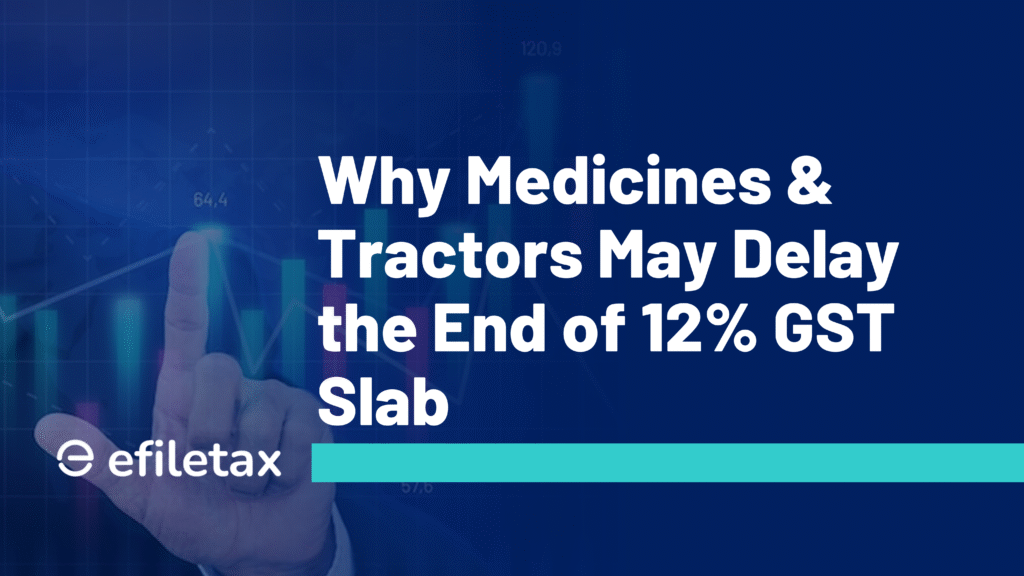
GST on Medicines and Tractors The 12% Slab Debate
India’s long-awaited GST slab rationalisation faces new hurdles—this time from essential sectors. While there’s consensus on trimming the current four-rate structure, medicines and tractors have emerged as bottlenecks to scrapping the 12% GST slab altogether.
Let’s decode what’s happening and what it means for Indian taxpayers and businesses.
What Is the GST Slab Rationalisation Plan?
The GST Council, under pressure to simplify compliance and improve revenue neutrality, has been working to reduce India’s four major GST rates—5%, 12%, 18%, and 28%—into a more manageable three-rate structure.
- The proposal is to merge the 12% and 18% slabs, creating a unified mid-rate.
- However, this merger would push several essential goods like life-saving medicines, agricultural machinery, and tractors into the higher 18% tax bracket.
This has triggered industry and political pushback.
Why Medicines and Tractors Are Exemptions-in-Waiting
Medicines
- Many essential drugs, including vaccines, are taxed at 5%, but a wide range still falls under 12%.
- Shifting these to 18% could make healthcare unaffordable, violating public health policy goals.
Tractors and Agri Inputs
- Tractors currently attract 12% GST, but the farm sector is largely income-tax exempt.
- A hike to 18% would raise capital costs in agriculture, hurting small farmers and inviting political backlash, especially ahead of elections.
Legal and Policy Dimensions
- As per GST Council Meeting Notes (2024-25), a complete slab overhaul needs consensus from all states.
- Rule changes impacting medicines or agriculture require a calibrated compensation mechanism under Article 279A of the Constitution.
- Industry groups like FICCI and CII have submitted representations opposing any upward revision in GST for health and agri goods.
CBIC data (2024): Nearly ₹1.3 lakh crore worth of medicines are sold under the 12% slab annually. Raising this to 18% could spark inflation.
Expert View: Revenue vs Welfare
According to CA Arvind Krishnamurthy, a GST policy advisor:
“While merging slabs makes economic sense, policymakers must balance revenue efficiency with social equity. A sudden jump in tax on tractors or insulin will hit the masses directly.”
What Could Happen Next?
The GST Council may adopt a phased rationalisation, where:
- Luxury or discretionary 12% items move to 18%
- Core items like tractors and medicines remain at 12%, possibly under a special rate notification or new exempt category
A potential mini-budget post-election could revisit this with more clarity.
Quick Snapshot (for Mobile Users)
| Item | Current GST | Post-Merger Risk | Policy Stand |
|---|---|---|---|
| Tractors | 12% | Could rise to 18% | Likely to stay at 12% |
| Essential Medicines | 12% | Could rise to 18% | Exemption under review |
| Fertilizers | 5% | Unaffected | Exempt continues |
| Automobiles | 28% | No change | Luxury rate stays |
Practical Tip for Businesses
If you’re in pharma or agri equipment, expect input GST credit and pricing models to remain stable at least until March 2026, unless a mid-year Council revision occurs.
Plan procurement and contracts accordingly.
FAQ Section
Q1: Is GST on tractors going up?
No. Currently at 12%, and unlikely to be increased due to farmer impact.
Q2: Will medicine prices rise if slab merger happens?
Possibly, but key health drugs are expected to stay at 12%.
Q3: When will GST slabs be revised?
Rationalisation talks are ongoing. Next concrete steps expected after Lok Sabha elections.
Final Word
GST slab rationalisation remains a work-in-progress, with tractors and medicines emerging as critical holdouts in India’s path toward tax simplicity. The 12% slab, while inefficient, may continue for now—serving as a policy cushion for welfare sectors.
Need help with GST compliance or rate classification?
👉 Talk to Efiletax GST Experts for updated guidance.
Summary
The 12% GST slab may stay as tractors and medicines resist rate hikes. While the GST Council aims for simplification, essential sectors need protection. Learn why merging 12% and 18% rates isn’t easy, what’s next, and how it impacts your business or tax planning.